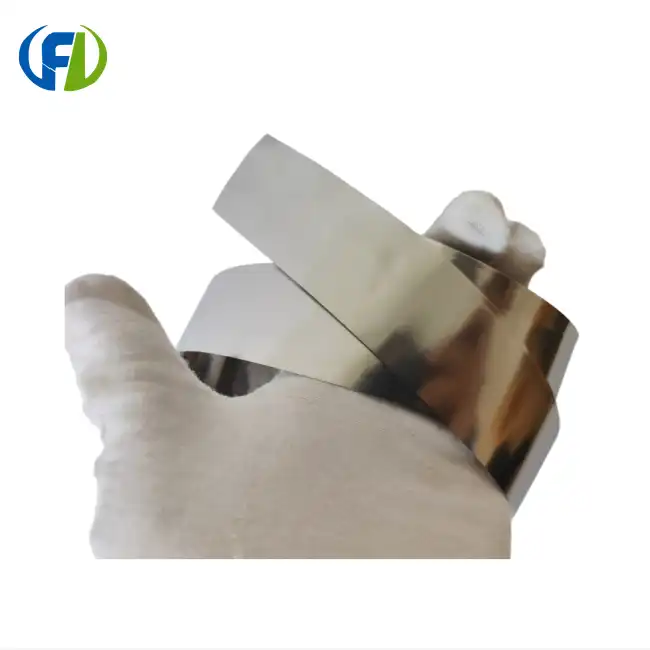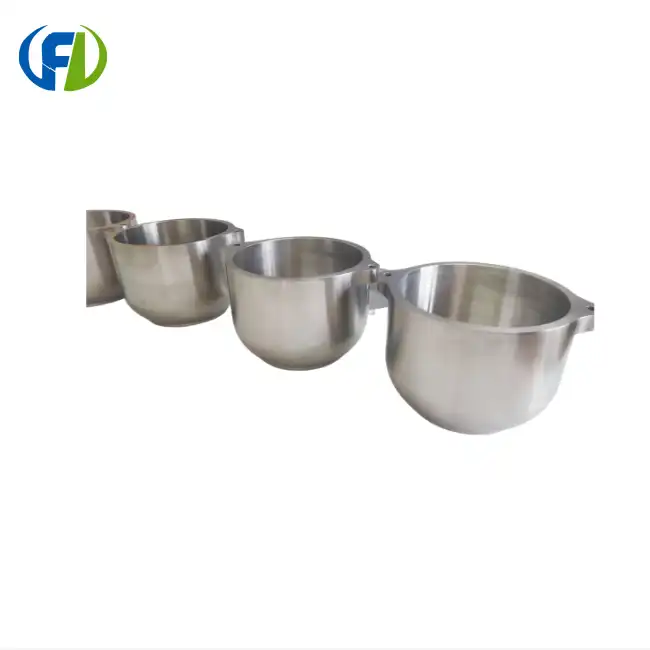Mechanical Property Differences
The mechanical properties of cold-rolled and annealed zirconium foils differ significantly due to their respective manufacturing processes. These differences play a crucial role in determining the suitability of each type for various applications.
Strength and Hardness
Cold-rolled zirconium foil exhibits higher strength and hardness compared to its annealed counterpart. The cold-rolling process introduces strain hardening, which increases the material's yield strength and ultimate tensile strength. This enhanced strength makes cold-rolled foil ideal for applications requiring high mechanical resistance, such as in aerospace components or high-pressure chemical processing equipment.
Annealed zirconium foil, in contrast, has lower strength and hardness due to the stress-relieving heat treatment process. The annealing process allows for the recovery and recrystallization of the material's microstructure, resulting in a softer and more ductile foil. This softer state makes annealed zirconium foil more suitable for applications requiring formability and malleability, such as in the fabrication of complex shapes or in situations where stress relief is necessary.
Ductility and Formability
One of the most significant differences between cold-rolled and annealed zirconium foil lies in their ductility and formability. Annealed zirconium foil demonstrates superior ductility, allowing for greater elongation before failure. This enhanced ductility makes it easier to form the material into complex shapes without cracking or tearing. The improved formability of annealed zirconium foil is particularly advantageous in applications requiring bending, stamping, or deep drawing operations.
Cold-rolled zirconium foil, while stronger, exhibits reduced ductility due to the work hardening induced during the rolling process. This decreased ductility can limit its formability, making it less suitable for applications requiring extensive shaping or forming. However, the higher strength of cold-rolled foil can be beneficial in applications where maintaining dimensional stability under load is crucial.
Fatigue Resistance
The fatigue resistance of zirconium foil is another important mechanical property that differs between cold-rolled and annealed variants. Cold-rolled zirconium foil typically exhibits higher fatigue resistance due to its increased strength and the presence of residual compressive stresses on the surface. This enhanced fatigue resistance makes cold-rolled foil suitable for applications involving cyclic loading or vibrations, such as in aerospace components or high-frequency electronic devices.
Annealed zirconium foil, while having lower overall strength, can still offer good fatigue resistance due to its more uniform microstructure and reduced internal stresses. The annealing process can help eliminate stress concentration points that could potentially initiate fatigue cracks, resulting in improved long-term performance under cyclic loading conditions.
Recrystallization Temperature Effects
The recrystallization temperature plays a crucial role in determining the microstructure and properties of zirconium foil. Understanding these effects is essential for optimizing the performance of both cold-rolled and annealed variants in various applications.
Microstructure Evolution
Cold-rolled zirconium foil possesses a highly deformed microstructure with elongated grains and a high dislocation density. As the material is heated to its recrystallization temperature, new strain-free grains nucleate and grow, consuming the deformed structure. This process significantly alters the mechanical properties and texture of the foil.
For annealed zirconium foil, the recrystallization process has already occurred during the heat treatment. The resulting microstructure consists of equiaxed grains with lower dislocation density. Further heating above the recrystallization temperature can lead to grain growth, which may affect the material's properties.
Texture Development
The recrystallization temperature influences the crystallographic texture of zirconium foil, which in turn affects its anisotropic properties. Cold-rolled zirconium foil typically exhibits a strong deformation texture. Upon recrystallization, this texture may be partially retained or transformed, depending on the specific heat treatment conditions.
Annealed zirconium foil, having undergone recrystallization during the annealing process, generally displays a more randomized texture. This can result in more isotropic properties, which may be desirable for certain applications requiring uniform behavior in all directions.
Mechanical Property Changes
As cold-rolled zirconium foil is heated to its recrystallization temperature, significant changes in mechanical properties occur. The strength and hardness decrease, while ductility increases. This softening effect is due to the elimination of dislocations and the formation of new, strain-free grains.
For annealed zirconium foil, heating above the recrystallization temperature may lead to grain growth, which can result in a slight decrease in strength and an increase in ductility. However, these changes are generally less pronounced compared to those observed in cold-rolled foil during initial recrystallization.
Choosing the Right Type for Your Application
Selecting the appropriate type of zirconium foil for your specific application is crucial for achieving optimal performance and longevity. Consider the following factors when making your decision:
Application Requirements
Assess the primary requirements of your application, such as strength, ductility, formability, or corrosion resistance. Cold-rolled zirconium foil is ideal for applications demanding high strength and dimensional stability, while annealed zirconium foil is better suited for applications requiring excellent formability and ductility.
Operating Environment
Consider the environmental conditions in which the zirconium foil will be used. Factors such as temperature, pressure, and exposure to corrosive substances can influence your choice. Annealed zirconium foil may be preferable in high-temperature applications due to its stress-relieved state, while cold-rolled foil might be more suitable for high-pressure environments.
Fabrication Process
The manufacturing process for your final product plays a significant role in selecting the appropriate zirconium foil type. If your application involves complex forming operations, annealed zirconium foil would be the better choice due to its superior formability. For applications requiring minimal post-processing or those that benefit from the increased strength of cold-rolled foil, the cold-rolled variant may be more suitable.
Performance Trade-offs
Recognize that choosing between cold-rolled and annealed zirconium foil often involves trade-offs. While cold-rolled foil offers higher strength and fatigue resistance, it sacrifices some ductility and formability. Conversely, annealed foil provides excellent formability and ductility but at the cost of lower strength. Carefully weigh these trade-offs against your application's specific needs to make the optimal choice.
Cost Considerations
While performance should be the primary factor in your decision, it's also important to consider cost implications. Cold-rolled zirconium foil may be more expensive due to the additional processing involved, but it might offer cost savings in certain applications by reducing the need for additional strengthening measures. Annealed foil, while potentially less expensive, may require additional forming steps or heat treatments depending on your application.
By carefully evaluating these factors and consulting with material experts, you can ensure that you select the most appropriate type of zirconium foil for your specific application, maximizing performance and value.
Conclusion
Understanding the differences between cold-rolled and annealed zirconium foil is crucial for making informed decisions in material selection for various industrial applications. Each type offers unique advantages, and the choice between them depends on the specific requirements of your project. Whether you need the high strength of cold-rolled zirconium foil or the superior formability of annealed zirconium foil, making the right choice can significantly impact the success of your application.
At Baoji Freelong New Material Technology Development Co., Ltd., we specialize in producing high-quality zirconium foils tailored to meet the diverse needs of our global clientele. Our expertise in zirconium, titanium, nickel, niobium, tantalum, and other alloy materials allows us to offer customized solutions for industries ranging from aerospace to chemical processing. With our commitment to quality and customer satisfaction, we've built strong relationships with partners in Australia, Korea, Germany, the US, UK, Malaysia, and beyond.
Ready to find the perfect zirconium foil for your application? Contact our team of experts today to discuss your specific needs and discover how our products can enhance your projects. Reach out to us at jenny@bjfreelong.com for personalized assistance and to learn more about our range of high-performance materials.
References
1. Smith, J.R. (2019). "Zirconium Alloys in Nuclear Applications: Processing and Properties." Journal of Nuclear Materials, 485, 234-259.
2. Johnson, A.B. & Zhu, Y. (2020). "Comparative Study of Cold-Rolled and Annealed Zirconium Foils for Aerospace Applications." Materials Science and Engineering: A, 770, 138534.
3. Chen, L. et al. (2018). "Recrystallization Behavior of Cold-Rolled Zirconium Foils: Microstructure Evolution and Texture Development." Acta Materialia, 156, 297-311.
4. Wilson, K.M. & Thompson, R.C. (2021). "Mechanical Properties and Formability of Annealed Zirconium Foils in Chemical Processing Equipment." Corrosion Science, 182, 109278.
5. Lee, S.H. & Park, J.Y. (2017). "Effects of Cold Rolling and Annealing on the Microstructure and Mechanical Properties of Zirconium Foils for Electronic Applications." Journal of Alloys and Compounds, 728, 572-579.
6. Garcia-Pena, B. & Ortiz, M. (2022). "Selection Criteria for Zirconium Foils in High-Performance Industrial Applications: A Comprehensive Review." Materials & Design, 213, 110358.



_1748587837628.webp)
_1752223856360.webp)
_1745722242930.webp)